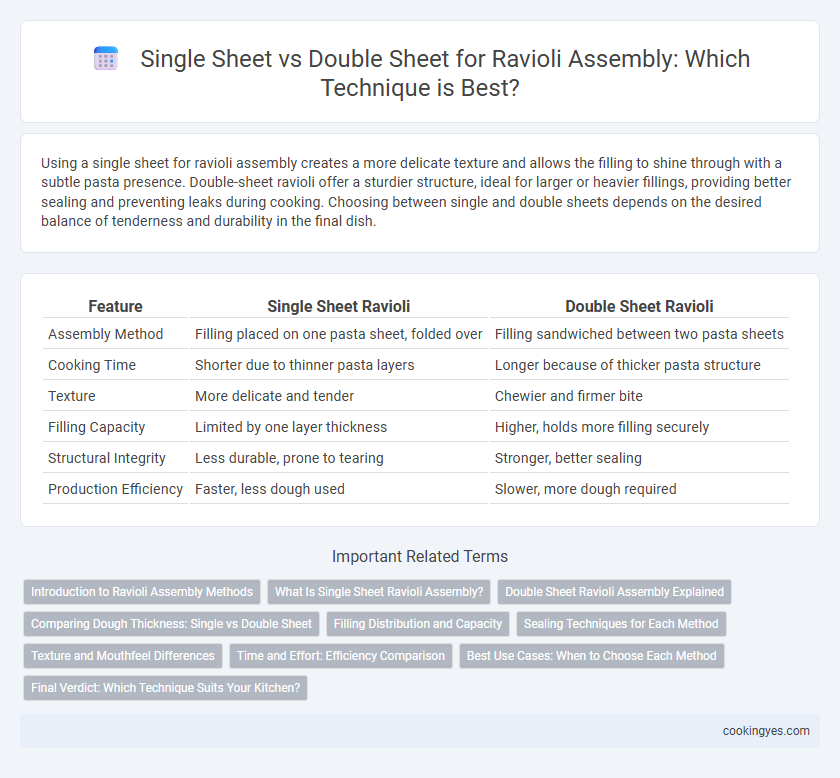Using a single sheet for ravioli assembly creates a more delicate texture and allows the filling to shine through with a subtle pasta presence. Double-sheet ravioli offer a sturdier structure, ideal for larger or heavier fillings, providing better sealing and preventing leaks during cooking. Choosing between single and double sheets depends on the desired balance of tenderness and durability in the final dish.
Table of Comparison
| Feature | Single Sheet Ravioli | Double Sheet Ravioli |
|---|---|---|
| Assembly Method | Filling placed on one pasta sheet, folded over | Filling sandwiched between two pasta sheets |
| Cooking Time | Shorter due to thinner pasta layers | Longer because of thicker pasta structure |
| Texture | More delicate and tender | Chewier and firmer bite |
| Filling Capacity | Limited by one layer thickness | Higher, holds more filling securely |
| Structural Integrity | Less durable, prone to tearing | Stronger, better sealing |
| Production Efficiency | Faster, less dough used | Slower, more dough required |
Introduction to Ravioli Assembly Methods
Ravioli assembly can use either a single sheet or double sheet method, each influencing texture and filling containment. The single sheet method involves placing filling on one pasta sheet and folding it over, creating a seamless base with fewer layers. The double sheet method sandwiches the filling between two pasta sheets, offering sturdier structure and a classic ravioli appearance.
What Is Single Sheet Ravioli Assembly?
Single sheet ravioli assembly involves placing filling on a single pasta sheet, then folding or layering it to enclose the filling before cutting individual ravioli pieces. This method simplifies the process by using one continuous dough layer, reducing the risk of air pockets and ensuring even cooking. Single sheet ravioli is ideal for homemade recipes and small-scale production, offering a delicate texture and consistent thickness.
Double Sheet Ravioli Assembly Explained
Double sheet ravioli assembly involves placing a filling layer between two separate sheets of pasta dough, ensuring even thickness and secure sealing along the edges to prevent leakage during cooking. This method allows for precise portion control and consistent shape, resulting in uniform cooking times and a refined presentation. Using double sheets enhances the texture contrast, as the pasta fully encloses the filling, preserving moisture and intensifying flavor.
Comparing Dough Thickness: Single vs Double Sheet
Single-sheet ravioli assembly typically uses a thicker dough layer that provides a sturdier texture and holds fillings securely without tearing. Double-sheet ravioli allows for thinner dough layers on each sheet, enhancing a delicate bite while balancing structural integrity through two layers. Thickness variations impact cooking time, texture, and filling support, with single sheets favoring durability and double sheets optimizing tenderness.
Filling Distribution and Capacity
Using a single sheet for ravioli assembly allows for thicker, more evenly distributed filling, optimizing the flavor and texture balance in each piece. Double sheet assembly provides increased filling capacity and structural support, which is ideal for larger or more complex filling mixtures but may result in slightly less uniform filling distribution. Proper sealing between sheets is essential to maintain filling integrity and prevent leakage during cooking.
Sealing Techniques for Each Method
Single sheet ravioli assembly requires precise sealing along the edges using techniques like crimping with a fork or pressing with a ravioli stamp to prevent filling leakage. Double sheet methods involve layering two pasta sheets and sealing by pressing around each pocket, often complemented by a light egg wash or water to enhance adhesion. Proper sealing in both methods is crucial for maintaining shape during cooking and ensuring the ravioli holds the filling without bursting.
Texture and Mouthfeel Differences
Single-sheet ravioli typically offers a thinner, more delicate texture that allows the filling's flavor to be more prominent, creating a lighter mouthfeel. Double-sheet ravioli provides a thicker, chewier outer layer, adding a heartier bite and contrasting texture that can better support dense or robust fillings. The choice between single and double sheets significantly influences the balance between pasta and filling, affecting the overall eating experience.
Time and Effort: Efficiency Comparison
Using a single sheet for ravioli assembly reduces preparation time by minimizing dough handling and speeds up the filling process, enhancing overall efficiency. Double-sheet ravioli requires careful alignment and sealing between layers, increasing effort and prolonging assembly time. Opting for a single sheet streamlines production, making it ideal for high-volume or time-sensitive cooking environments.
Best Use Cases: When to Choose Each Method
Single sheet ravioli assembly is ideal for smaller batches and delicate fillings, allowing for precise control and less dough waste. Double sheet construction suits larger volumes and heartier, moisture-rich fillings, providing a robust seal to prevent leaks during cooking. Choosing between single and double sheets depends on production scale and filling consistency for optimal texture and durability.
Final Verdict: Which Technique Suits Your Kitchen?
Choosing between single sheet and double sheet ravioli assembly hinges on kitchen efficiency, texture preference, and filling security. Single sheet ravioli, crafted by placing filling on one pasta layer topped with another, offers sturdiness and ease for home cooks seeking uniform pockets with less handling. Double sheet ravioli, involving two separate sheets encasing the filling, suits commercial kitchens prioritizing high volume and consistent sealing, ensuring a tender bite with minimal risk of bursting during cooking.
Single sheet vs double sheet for ravioli assembly Infographic

 cookingyes.com
cookingyes.com